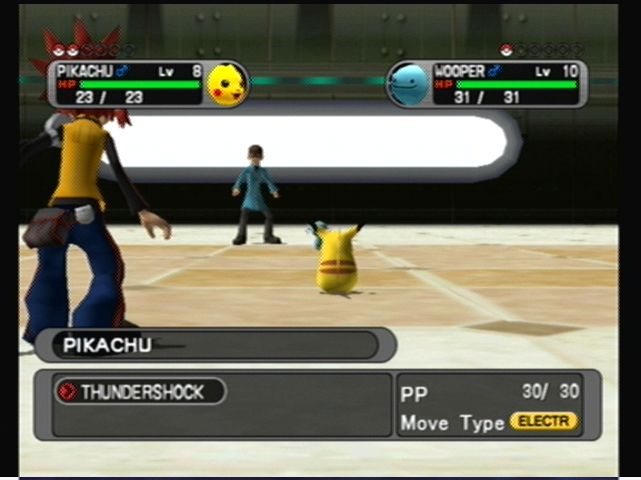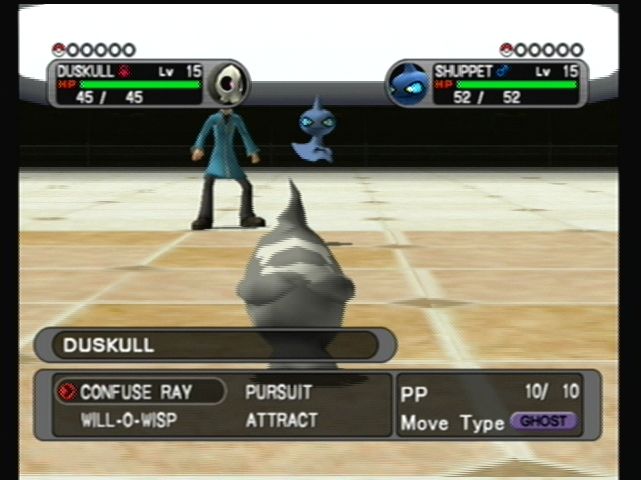The first SIM battle deals with status effects.

SIM battles are all held within the same virtual space used for the purify chamber. First we enter it,

then a SIM trainer is generated, and then the environment is transformed into a real battle space.
The opponent's Pokemon starts with a burn, and we start with--

not funny.
Magikarp is infamous because the only move she knows until level 15 is Splash, which is literally a pass turn move. From this generation of Pokemon on, she also learns Flail at L30. Magikarp evolves at level 20. Flail is only for hardcore Magikarp fans.

This entire battle basically takes place inside the item screen. Each turn, Paras afflicts us with a different status effect, and we use one of the items the game gives us to treat it. Then Paras takes burn damage, and the battle continues like this until we've treated every type of status effect and Paras' HP runs out. Paras' entire move set is Stun Spore, Poisonpowder and Sleep Powder. Paras can't actually learn any burn-inducing moves, which is why we start the battle off with burn.
With regards to how burn works, it's probably the second most abused status problem after paralysis because it cuts physical damage from the afflicted by 50% in addition to dealing 12.5% damage each turn.
You can't actually use the wrong item because the game will call you out on it being meaningless to do so.
Next is Pokemon Types and Move Types. This Rattata has 25 Attack versus its 10 Special Attack, and knows Quick Attack and Thunderbolt. Thunderbolt has a base power of 95 while Quick Attack has a BP of 40, but Rattata is the same type as Quick Attack so it gets a 1.5x damage multiplier and Quick Attack works off of Attack rather than Sp. Attack, so the final damage of Quick Attack is higher than Thunderbolt, 19 instead of 6. We only get two turns to work this out because Makuhita is using the Fighting-type Brick Break versus a Normal-type Rattata each turn for 2x damage, which means that you have to use Quick Attack on both turns to win. The AI will wipe the floor with you for any Thunderbolt usage.
Even after playing Pokemon for all these years, this one still surprised me because Makuhita has no resistances to either attack and the power disparity between Quick Attack and Thunderbolt is enormous. Despite that setup, the real winner here is Rattata's 25 Attack vs 10 Sp. Attack, because your attack power versus the opponent's relevant defensive stat has a much bigger impact in the damage formula than the power of an individual move.

Next is type matchups. The initial situation is easy. Magnemite is an Electric/Steel type, so it gets the Same Type Attack Bonus (STAB) from using the Electric-type Thunderbolt, and Goldeen is a Water-type so she takes double damage from Electric attacks.

Then the opponent sends out Sandshrew after Goldeen goes down, and it's time to switch Pokemon or take an Earthquake for a OHKO. The Tangela we switch into is a Grass-type and Sandshrew is a Ground-type, so while Tangela resists Earthquake's Ground damage, Sandshrew takes double damage from her Vine Whip.
Next up, multitarget moves. This one's a double battle. Marill has Surf and Geodude has Earthquake; Surf hits both of the opponents, but deals super effective damage to Slugma because he's a Fire-type and Surf is a Water move. Earthquake meanwhile is super effective versus Electrike because she's an Electric-type facing a Ground move, but Earthquake comes with the caveat that it also hits your allies, taking Marill down to single digit HP. Earthquake has the most synergy when used with a Pokemon that has the Levitate ability, or with Ghost-type team members, because Levitating Pokemon are in the air and Ghosts are outright unaffected by physical attacks.
This one's on multitype Pokemon. OKAY WOW NO, this one's mean. Wooper is a Water-type but it's a dual type Pokemon with Ground as its secondary, so Pikachu's Thundershock is going to be nullified if we try it. I switch out for Treecko instead, using Absorb for 4.5x damage because both Water and Ground have a double weakness to Grass on top of the STAB bonus.
Next, switching. Flying-type Pokemon take double damage from Electric moves, so Pikachu's Thundershock would be dealing 2.5x damage to this Pidgey. So instead we swap Geodude in, who nullifies the Thundershock damage with his Ground typing, then OHKOs Pikachu with Earthquake. The SIM Trainer then sends out Paras, and we switch for Pidgey. Paras has Giga Drain, a Grass-type move that would hit Geodude for 2.5x damage. Flying types deal double damage to Bug types, and double again to Grass, so against Paras' dual Grass/Bug our Flying-type Gust is going for 4.5x damage for a two turn knockout.
And now we're onto Abilities. Diglett is going to use Magnitude, a variation on Earthquake which can deal damage on an order of Magnitudes 1-9, so it has higher potential damage but is somewhat more random.

Both of our Pokemon are Poison-types versus Diglett's Ground, so either would take 2.5x damage from a STAB Magnitude, but Koffing's Levitate would cause Magnitude to fail entirely so we swap our Pokemon on the spot. Both Pokemon are stuck with the Poison-type Sludge as their only move, so their damage is halved against Diglett, but Koffing is literally untouchable right now because of his Levitate ability.
Held items are next on the list. This Taillow comes into the battle holding a Sitrus berry, which allows the holder to restore its HP by 30. Pokemon automatically use berries at the end of a turn in which their HP has fallen to 50%, although there is an ability that causes them to use them at higher HP intervals. So when Taillow's HP hits 14 or below, he'll heal himself to full. Wingull is Water/Flying and Taillow is pure Flying, so while there are no type advantages at work, both are dealing 1.5x damage from Water Gun and Peck, respectively. We win this SIM battle basically through attrition.
Status problems again! This time, we're the ones inflicting them. Both Pokemon are Ghost-type and deal normal damage to one another. Pursuit is not going to instrumental in this battle except as a basic damaging move because its special characteristic is that it does damage to a Pokemon before it can be switched out, and does double damage if that Pokemon would be switched out, basically guaranteeing that it will faint if the opponent is trying to fix a bad matchup. Right now there's only one Pokemon in play for either side. Confuse Ray, Will-O-Wisp and Attract are our focus; these inflict confusion, burn and infatuation. Confusion causes a Pokemon to hurt itself 50% of the time instead of attacking.

Attract only works against Pokemon of opposite genders, and causes the afflicted Pokemon to fail to attack 50% of the time. So by inflicting both, we can lock Shuppet down from attacking while whittling his hit points away with burn damage and Pursuit. The hangup here is that Shuppet always uses Astonish, which is super effective and causes Duskull to Flinch, wasting the turn. Four hits of Astonish will knock us out, although to make up for that Pursuit's Dark typing will deal double damage on top of the status effects severely debilitating Shuppet. This is one of the harder SIM battles, since Shuppet can take Duskull down to critical HP so quickly while locking her out of her moves with Flinching.
This time, stat modification is the focus. Each turn Chansey uses Softboiled, a move exclusive to herself that heals all of her HP at once. The key move for us is Cubone's Swords Dance, which raises her Attack by two stages every time that it's used. All stats in Pokemon are affected by their Stage power, with base stats being stage 0, and lower or higher stages increase them by a percentage. For example, at Stage +6 you have 400% of the original stat, while at stage -6 you have 25% of the original stat. We have 200% after one Swords Dance, so with three we're at 400% and 72 Attack instead of 18, which lets Headbutt go for uhh
Damage = ((((2 * 13/ 5 + 2) * 72 * 70 / 10) / 50) + 2) * RandomNumber / 100Maximum 74 damage versus 88 HP. That's not gonna be enough, so we're gonna use Tail Whip to lower Chansey's Defense by one stage each turn, until it's at -6. This puts our maximum damage count at 365 to KO Chansey four times over, so yes stat changes matter a lot.
Next up are weather combos. I confess, I forgot that the banana dragon existed. Tropius' ability is Chlorophyll, which doubles his Speed in sunny weather. Considering that this is the most important stat in Pokemon, it's not a bad ability. Our Tropius here has 25 base Speed, which is initially lower than this Chansey's (which I'm eyeballing at 26-31) causing her to go first. Chansey has Shock Wave, and Electric-type attacks deal double damage in the rain, so if we used Rain Dance Chansey could slay us immediately on a critical hit. Instead we use Sunny Day to trigger the sunny weather and double our Speed to 50. Another effect of sunny weather is that Solarbeam, which normally has to charge for a turn while the Pokemon gathers solar energy to photosynthesize, can be used immediately instead.

So using Sunny Day we're touting 50 Speed which causes our STAB Solarbeam to go off first, KOing Chansey after four hits. There are better ways to trigger sunny weather in competitive play than using a move to do it, although we won't see them because prior to the fifth generation, only one Pokemon can do it and it's not in XD.
The final SIM Battle is on double battle combos, and it's with a pair of Pokemon that should be very familiar to XD trainers. The setup here is that Pikachu is an Electric type and will be dealing 2.5x damage to Vaporeon, probably for a OHKO. However, Vaporeon has higher Speed than Pikachu and will be attacking first; Eevee does not.

But Eevee has the Helping Hand move, which has +5 priority and so gets to go before all but one of every other move in the game. Helping Hand raises the base power of an allied Pokemon's move by 50%, so Vaporeon's Surf goes from 95 to 142, hitting for Hyperbeam-levels of power after STAB is applied.

This OHKOs both Pokemon before they can even act. A high note to end the SIM Battles on.
For spending two hours on SIM training we get...nothing. Well, little gold stars. It was kinda fun.













No comments:
Post a Comment